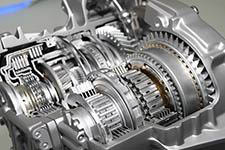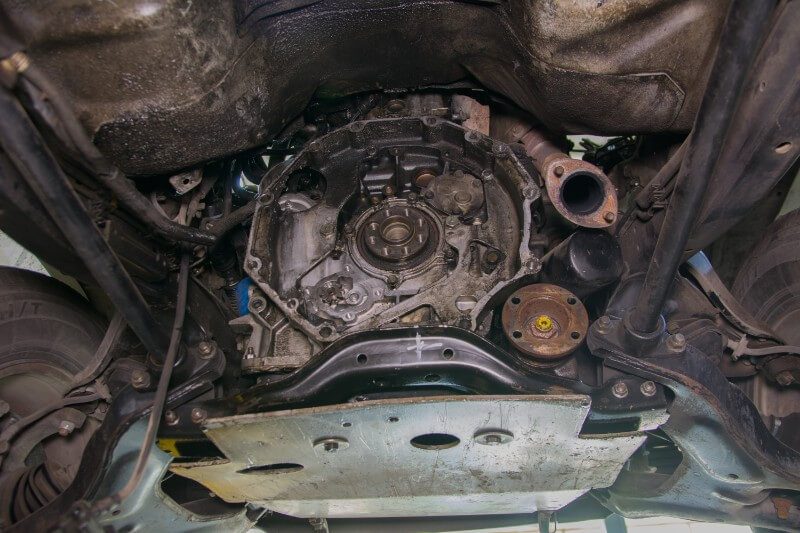Transmission Repair Services
Automatic Transmission
Automatic Transmissions shift between gears automatically to optimize driving, and changes gears based on the driver’s throttle pedal, vehicle speed, engine speed, and vehicle load. Typical automatic transmissions have 4-5 forward gear ratios, a Reverse, Park, and Neutral gear. Shifting gears occur automatically once the car is in Drive and there is no need for a clutch pedal or gear shift like there is in a Manual Transmission. Automatic transmission repair is complicated based on all the components that make it up, and you need to have any automatic transmission issues properly assessed by auto mechanics.
Clutches
There are clutches in both automatic and manual transmission cars, and different types of clutches. When shifting gears, the clutch engages and disengages from the flywheel and transfers the torque through the transmission. Clutches should help your vehicle start and shift gears smoothly. The clutch in your car receives a lot of wear and can eventually wear out. If your clutch begins slipping irregularly or is making noises that are raising suspicion, contact J&E Auto Repairs to see if clutch replacement is necessary.
Four-Wheel Drive Transmission
A four-wheel (4×4) drive vehicle has differential gears, both front and rear axles, and a transfer case attached to the transmission. Four-wheel drive vehicles demand maintenance on the transfer case, front differentials, rear differentials, and transmission fluids. Visit us on 600 23rd St for service on your four-wheel drive transmission services.
Front-Wheel Drive Transmission
If your vehicle has Front-wheel drive, the engine drives the front wheels only. The power is routed through the transmission to the final drive where it is split and sent to the two front wheels through the drive axles. The engine, transmission, and additional hardware is all located in the front of the car.
Manual Transmission
Driving a vehicle with a Manual Transmission requires using the clutch pedal and gear shift to manually shift gears based on the speed of the vehicle. Manual transmissions have been built with anywhere from two to eight gears. Front-wheel drive and rear-wheel drive are the two main configurations for manual transmissions. Typically, manual transmissions require less maintenance then automatic transmissions.

My Car is Shifting Funny, is it Time for Transmission Repair?
The transmission’s primary function is to transfer the power created by the engine to the wheels, via the driveshaft. With general maintenance the transmission shouldn’t have any trouble lasting a couple hundred thousands of miles. If left neglected, or if your car just happens to have an odometer that has rolled over enough times, you may begin to experience a few issues. If you start to notice funky shifting you’ll want to get to an auto repair shop right away before bigger issues develop. The following are some of the most common signs of a failing transmission.
Falling out of gear
One of the most dangerous signs of transmission trouble is if your vehicle suddenly falls out of gear or pops into neutral. This issue prevents you from being able to properly control your car, as you no longer can dictate power going to the wheels. Be sure to get to a repair shop the first time this happens to lessen the chances of bigger problems, including an accident.
Delayed shifting
If your vehicle’s engine revs high while shifting there is a good chance that the transmission is low on transmission fluid or the transmission fluid is contaminated.
Grinding noises
Perhaps the most common sign of transmission trouble is a strange noise that occurs while shifting. There are various sounds that may be heard and are often described as a grinding, squealing, or whining sound. However you want to describe it, it isn’t good!
Erratic shifting
If your automatic transmission seems to shift for no reason or at times when shifting is not necessary you will want to get to the shop. This can be caused by computer related issues or simply because of a lack of transmission fluid.
Transmission Services
Your vehicle’s transmission is not something to mess around with. If it’s experiencing problems, finding a professional who can effectively deal with them is paramount
when they need external transmission repair in Butler, PA because they know we’ll put the work in to make things right. We don’t ship your transmission off to someone else or put a bandage on the problem. Instead, we apply our in-house expertise and resources to repair, rebuild and reseal your transmission.
Repair
If your transmission is grinding or your gears are slipping, we’re here to offer you external transmission repair in Butler, PA. Our experts will diagnose your transmission and recommend the best solution for you.
Replacements
If a transmission replacement in Butler, PA is your only option, allow us to make the switch for you. We can help you track down a transmission and facilitate the new installation.
Resealing
If there are red stains on your garage floor, it’s time to have your case resealed. We’ll restore your transmission case to the hermetically safe state it’s supposed to have, flush out debris and fluid and replace everything. The result is a case that’s protected and free of friction-causing contaminants.
Transmission Noises and Vibrations
When your car starts making strange noises or vibrations, it’s never a good thing – especially if it’s coming from the transmission. Noise – whether it’s banging, grinding or scraping – means that two parts are coming into contact that aren’t supposed to. Those sounds are your warning that trouble’s coming, and you need to take action right away. Each day that goes by raises the likelihood of a costly transmission repair on the horizon.
You know your car better than anybody, and if you want to help us identify the potential source of your transmission noise faster there are things you can do. Take a few minutes to review the list below, then listen carefully to see which of these describes what you’re hearing or feeling. By doing so, you can eliminate some needless steps and help us pinpoint the source of the problem.
Automatic Transmissions
Most cars sold today have automatic transmissions. They make driving much easier, but their technology is much more complicated than that of manual transmissions, and that means that there are more things that can break down and cause transmission noise. Here are just a few of the typical automatic transmission noises, and what they often mean
Manual Transmissions
Generally speaking, manual transmissions make more sound than automatic transmissions, and this is especially true in older model vehicles. Though some sounds are normal and can’t be eliminated, new sounds are definitely cause for concern. You need to know whether what you’re hearing is a sign that you need a manual transmission repair
Because they have fewer parts, it’s generally easier to identify manual transmissions problems. Here are the most common sounds to listen for, and what they often mean.
Noise heard no matter what gear the vehicle is in. This problem is usually caused by improper or low transmission fuel levels.
Noise hear in one particular gear. Usually means that there’s damage to that gear.
Noise heard in forward gears, but not reverse or neutral. Usually means a problem with the counter shaft.
Noises heard whenever the clutch is engaged or disengaged. This is usually not caused by the transmission; it’s most often a problem with the clutch bearing.
Noise appears when the transmission is in neutral but the clutch is engaged. This is usually a problem with the bearings or input shaft.

TRANSMISSION REPAIR SERVICES
Automatic Transmission
Automatic Transmissions shift between gears automatically to optimize driving, and changes gears based on the driver’s throttle pedal, vehicle speed, engine speed, and vehicle load. Typical automatic transmissions have 4-5 forward gear ratios, a Reverse, Park, and Neutral gear. Shifting gears occur automatically once the car is in Drive and there is no need for a clutch pedal or gear shift like there is in a Manual Transmission. Automatic transmission repair is complicated based on all the components that make it up, and you need to have any automatic transmission issues properly assessed by auto mechanics.
Clutches
There are clutches in both automatic and manual transmission cars, and different types of clutches. When shifting gears, the clutch engages and disengages from the flywheel and transfers the torque through the transmission. Clutches should help your vehicle start and shift gears smoothly. The clutch in your car receives a lot of wear and can eventually wear out
Four-Wheel Drive Transmission
A four-wheel (4×4) drive vehicle has differential gears, both front and rear axles, and a transfer case attached to the transmission. Four-wheel drive vehicles demand maintenance on the transfer case, front differentials, rear differentials, and transmission fluids
Front-Wheel Drive Transmission
If your vehicle has Front-wheel drive, the engine drives the front wheels only. The power is routed through the transmission to the final drive where it is split and sent to the two front wheels through the drive axles. The engine, transmission, and additional hardware is all located in the front of the car.
Manual Transmission
Driving a vehicle with a Manual Transmission requires using the clutch pedal and gear shift to manually shift gears based on the speed of the vehicle. Manual transmissions have been built with anywhere from two to eight gears. Front-wheel drive and rear-wheel drive are the two main configurations for manual transmissions. Typically, manual transmissions require less maintenance then automatic transmissions